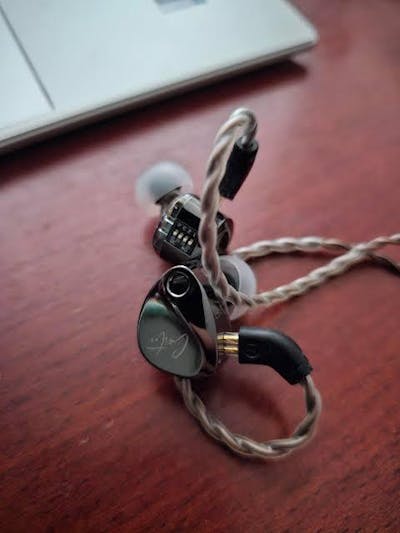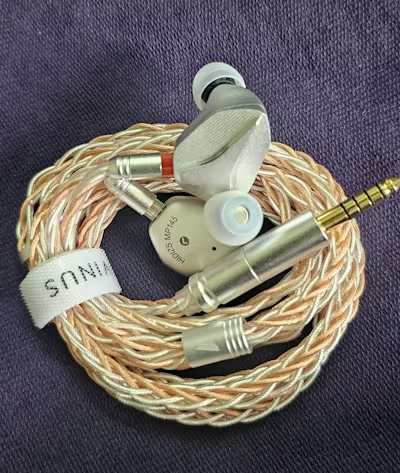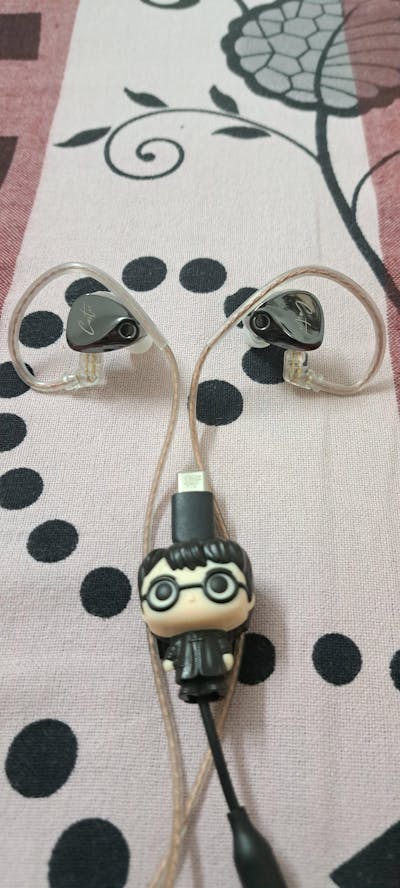Introduction
TANSIO MIRAI (TSMR) recently launched a new IEM, the TSMR Shock, equipped with a remarkable driver setup: 2 dynamic drivers, 4 balanced armature drivers, 2 bone conduction drivers, and 2 tuning knobs for sound adjustments. Priced at $599, its driver configuration looks exotic for this price point. Let’s dive deeper into the sound quality and see if the TSMR Shock is worth adding to your collection.

Design and Build Quality
The shell of the TSMR Shock is made from high-quality medical-grade resin, resembling a 3D-printed design. The faceplate design is simple and understated, featuring yellow and brown tuning knobs. The branding is minimal, with "TSMR" on the left and "Shock" on the right. The entire shell has a semi-transparent purple hue, which adds a subtle aesthetic appeal. The provided cable is a mix of white and purple, with metallic elements matching the IEM shell. The cable feels sturdy and well-built.
Overall, the design language is straightforward, but the build quality is undeniably robust.

Comfort and Fit
The TSMR Shock features a medium-sized shell that provides a secure fit. While the isolation is average, it's not a deal-breaker. I used the stock green stem and grey outer eartips, and I found the comfort and fit to be excellent. The IEMs can be worn for extended listening sessions without discomfort, making them ideal for long hours of music enjoyment.

Sound Quality
For my listening sessions, I used the HiBy R8 II digital audio player as my source, with stock cables and eartips. After experimenting with the tuning knobs (yellow for bass, brown for treble), I settled on a 3-yellow, 3-brown setting, which suited my preferences best. This review is based on that configuration.
The overall sound signature is V-shaped, delivering immersive, physical bass, crystal-clear treble, and a slightly recessed midrange. The soundstage is holographic and wide, with precise imaging.
Bass
As the name Shock suggests, the bass lives up to the title. It’s powerful, punchy, and head-filling, creating an almost subwoofer-like experience in your head. The bass is clean, detailed, and textured, with a slightly forward placement. Thanks to the tuning knobs, you can easily adjust the bass level to suit your preference, whether you're a bass-head or prefer a more restrained, polite bass. The bone conduction driver (BCD) truly works like magic, delivering a bass experience that's both unforgettable and lifelike. When you close your eyes and focus on the music, the low frequencies seem to travel through your skull, creating a visceral, immersive sound experience.
Midrange
With my chosen tuning (3-yellow, 3-brown), the midrange feels slightly recessed. However, when set to 0-yellow, 0-brown, the sound becomes more balanced, with the midrange taking a slightly forward position. The midrange tuning is typical of what you'd expect from IEMs in the $500-$600 range. While it's not groundbreaking, it delivers warm, rich, and natural vocals, especially for male singers. The upper midrange avoids harshness, and the overall midrange is thick and weighty without getting muddied by the powerful bass.
Treble
The treble on the TSMR Shock is musical, detailed, and smooth, with plenty of nuance and reverb. Like the bass, the treble can be adjusted via the brown knob, giving you control over the sparkle and brightness. The treble has enough sparkle to make it lively without becoming sharp or fatiguing. Its forward placement, like the bass, adds to the overall engaging sound. Instruments sound natural and realistic, contributing to a treble performance that's impressive, musical, and well-balanced.
Soundstage & Imaging
The TSMR Shock offers a holographic, wide, and deep soundstage with precise imaging. The sense of space and instrument separation is excellent, further enhancing the immersive experience.
Tuning Knobs
The TSMR Shock’s tuning knobs may seem daunting at first, but with a bit of experimentation, they become easy to understand. These knobs are a great feature for listeners who enjoy customizing their sound, especially adjusting the bass quantity and treble sparkle. While I’m not a huge fan of knobs, once you find your preferred setting, they become a fun and useful tool for creating a more personalized listening experience.

Value and Competition
At the moment, there are no other IEMs with a similar driver configuration at this price point, so I’ll leave this section open for future updates. However, the TSMR Shock stands out as a unique offering in its category.

Pros and Cons
| Pros | Cons |
|---|---|
| Immersive, powerful, and punchy bass | Average-looking IEM shell |
| Warm midrange | Tuning knobs could benefit from more educational content |
| Musical treble | Slightly recessed midrange |
| Wide soundstage | |
| Customizable tuning knobs | |
| Well-implemented bone conduction driver at $600 |

Conclusion
Is the TSMR Shock worth the investment? My answer is a resounding yes! If you’re looking for customizable bass and treble options, head-filling bass, and sparkly yet smooth treble, this IEM delivers. The V-shaped sound signature strikes a perfect balance between fun and detail. While the design may not be as visually striking as some other IEMs in this price range, the sound experience more than makes up for it.
I’d like to extend my thanks to Mr. Sandeep (Audio_Geek India) and the TSMR brand for allowing me to participate in this review tour. All opinions expressed here are my honest thoughts, uninfluenced by anyone.
If you have any questions, feel free to ask in the comments section below. If you enjoy our content, consider following our WhatsApp Channel. For our frequency graph database, kindly check here (link). Thanks for reading, and see you in the next one!






















